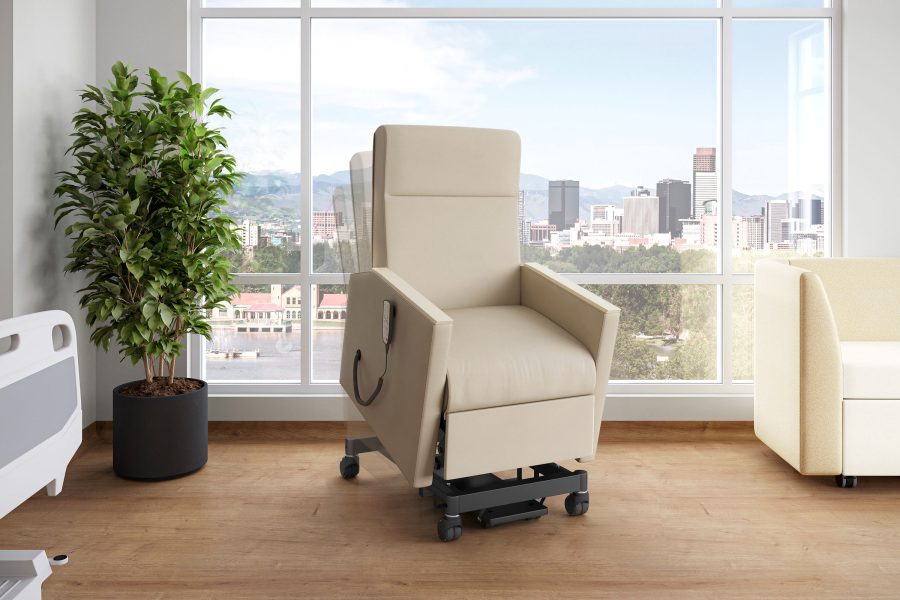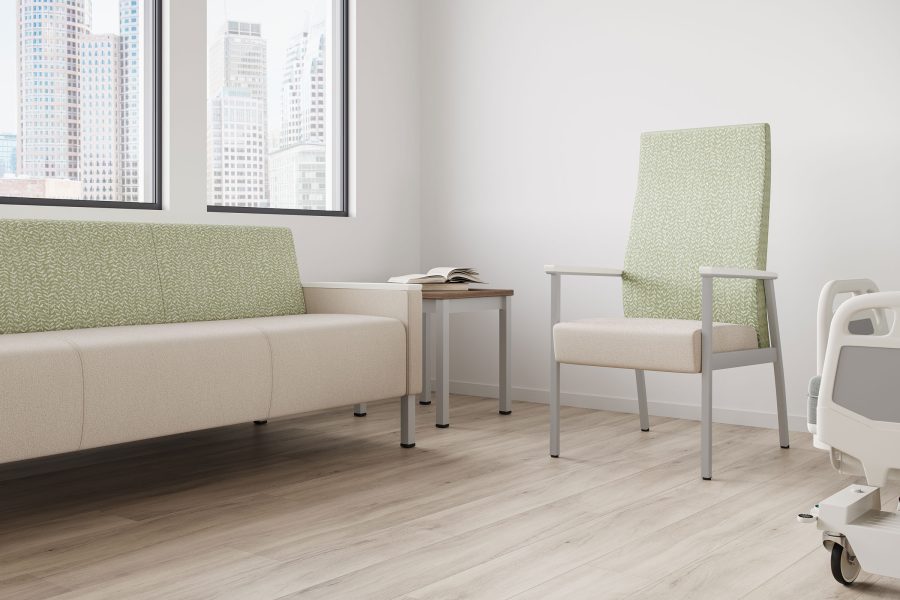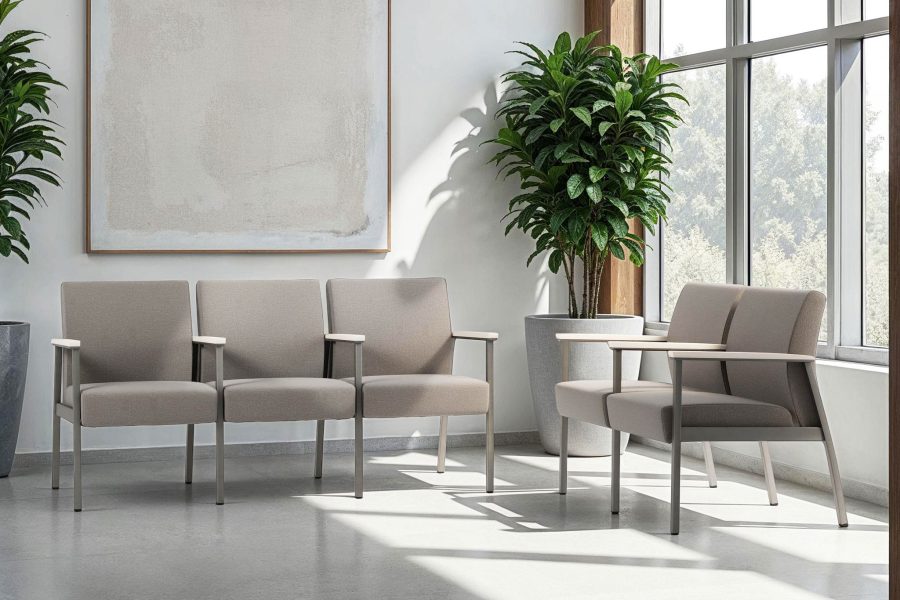Story at a glance:
- A medical facility’s design influences some of the most emotionally and physically intense events in our lives.
- The Environmental Services team limits cross-contamination and maintains healthy environments in hospitals and other medical facilities.
- Health care furniture balances aesthetics, comfort, and durability. It should also be easy to take apart and modify.
One mission motivated Laura Morris, principal and health practice leader at Perkins&Will, from the start of her career—design health care spaces that help people heal. “It’s what drives me,” she says.
Morris gained a new perspective on this goal when her parents became ill, and she saw firsthand why it’s vital to design for comfort and connection in health care.
First, her dad suffered a brain aneurysm and spent 28 days in the ICU. Although the facility had a variety of amenities for families, Morris says she still slept “in a lounge chair for multiple nights in a row and didn’t have a comfortable place to stay.”
She adds, “The staff tried to make it as comfortable as possible, but the experience had a huge influence on how I think about those spaces.”
Then Morris’ mother dealt with multiple bouts of cancer, receiving treatment at various facilities in Texas and New York.
“I had a lot of firsthand experience with different facilities, some of which we do design work for now,” Morris says. “In all honesty, if you haven’t been touched by it yet, you will.”
Even if it’s a joyous occasion like giving birth to a child in a hospital, the design of the physical space impacts your experience, Morris says. In fact, the design of health care spaces influences some of the most emotionally and physically intense events in our lives, whether it’s having a baby, a health scare of our own, or the illness or injury of a loved one. To create health care spaces with increased comfort and flexibility for patients, their families, and staff, furniture is a key piece of the puzzle.
“The first thing we usually do is understand the customer and who is going to be using the space,” Morris says. “Then we find the right design answer, which always includes furnishings as part of that solution.”
Comfortable Furniture Helps Patients Heal

Power and Lift recliners from La-Z-Boy Healthcare | Knú Comfort are operated with a hand wand to go from a seated to a standing position. Photo courtesy of La-Z-Boy Healthcare | Knú Comfort
Aesthetics are important in health care spaces. “Humans are at the core of what health care is,” Morris says, adding that humans prefer visually appealing places.
However, furniture is far from merely decorative—especially in health care.
For one, Morris points out that the comfort level of public seating in waiting rooms can influence how we feel about wait times. Patient evaluations even sway insurance reimbursement rates for health care facilities. In recent years questions about the physical space and how it felt weigh more heavily in patient scores.
A 2022 article in the International Journal of Health Technology and Innovation also called hospital furniture “an important part of any health care system,” stating that its “design and functionality can make or break the quality of care patients receive.”
Whether it’s a sleep sofa, recliner chair, exam lift, or visitor chair, comfortable furniture is crucial. “If they’re not comfortable, they’re going to have a hard time getting better,” says Adam Stemle, president of La-Z-Boy Healthcare | Knú Comfort, which supplies furniture for the health care market, like recliners, exam lift recliners, sleepers, public area seating, and fully upholstered lounge products.
If they’re not comfortable, they’re going to have a hard time getting better.
A place for a visitor to sit or sleep that supports your body? That helps loved ones better support patients, allowing visitors to rest, too, especially during long hospital stays. A recliner chair with wand controls that even a patient who’s injured, has limited mobility, or is exhausted can operate? That can allow a patient to adjust the chair to their liking, increasing comfort and independence at a time when the body is already in pain and it may be hard otherwise to do much without external help.
In 2017 Ohio researchers studied patients’ needs for hospital rooms and published their findings in HERD: Health Environments Research & Design Journal. They found that patients expect the hospital room to be comfortable enough to support healing, to help facilitate connection to people and the outside world, to provide speedy and independent access to their belongings, and to provide suitable levels of control.
La-Z-Boy Healthcare | Knú Comfort has a series of recliners that incorporate zero gravity functionality, which provides patients with a weightless feel and eliminates pressure points. Stemle says oncology and infusion departments find these recliners particularly useful because patients can be in the chair for long periods of time. He also noticed that orthopedics facilities appreciate the recliner because some patients may not be able to bend their knees or hips.
“Everything is wand-controlled so you can have three or four different motors operating different functions of the chair,” Stemle says. “All of those motors work together to provide positions that will take stress off of the back and make the patient experience a lot better.”
Morris says she also looks for furniture that helps the patient have everything they want near them, with options that allow them to control the experience themselves, rather than depending on a nurse to come into the room. This can mean wands that control the positioning of a chair as well as attachable trays and device stands or chargers integrated into the furniture.
Reducing Strain on Health Care Staff & Visitors

The Kenzley Sleep Sofa was crafted for superior comfort, durability, and cleanability. Photo courtesy of La-Z-Boy Healthcare | Knú Comfort
This year The Harris Poll surveyed 1,504 frontline health care employees, discovering that 55% planned to switch jobs by next year. Meanwhile, the American Hospital Association anticipates a shortage of about 100,000 critical health care workers by 2028.
“You see a tremendous exodus lately because of all the overwork and stress working in health care,” Stemle says. “We’re trying to work with our hospitals and our design firms to communicate with each other and make everybody a lot more comfortable in the space.”
In the health care arena a designer must consider not just the comfort of the patient but also the care team (doctors, nurses, etc.) and cleaning staff. “Comfort is more than just a feeling from somebody using the product,” Stemle says.
For example, if nurses have to constantly bend over to start a port or run an IV for a patient, their jobs become more strenuous, which might decrease the quality of care or contribute to already high turnover. Alternatively, when health care settings incorporate furniture that enables automated movement, that’s less strain on caregivers, benefiting patients and health care systems, too. In other words, with a press of a button the chair adjusts position and caregivers gain the flexibility they need to avoid additional discomfort in their bodies. The caregivers are “the ones who are using the product day in and day out,” Stemle adds.
If a facility often uses mobile lifts to transport patients, for instance, Stemle says, “We want to make sure our recliners are going to be tall enough for those lifts to go underneath the chair so the caregivers aren’t lifting patients day in and day out, putting stress on their backs and driving caregivers out of the industry.”
Environmental Services (EVS) staff also play a critical role in hospitals and other medical facilities, going far beyond the cleaning tasks in other kinds of environments like offices or hotels. The EVS team provides crucial disinfection and cleaning for equipment, patient rooms, and common areas. Their work limits cross-contamination and maintains healthy environments for patients to heal, medical staff to treat patients, and loved ones to support patients in their recoveries. Designers must keep EVS staff in mind, too.
Furniture needs to be “easy to clean, take apart, to get into different cracks and crevices, to make sure you’re not sticking your hand to where a syringe might be,” Stemle says.
What’s Next?

Kenzley Visitor combines form and function for people-centric design in health care spaces. Options range from high back to bariatric width and multi-seating. Photo courtesy of La-Z-Boy Healthcare | Knú Comfort
“We’re constantly in that battle between furniture being beautiful and comfortable but also being durable,” Morris says. “For a long time it was like, if it was durable, it was the worst thing in the world to sit on. But what’s the next thing?”
As technology continues to become more embedded in the health care system, furniture will adapt to the new reality. “Technology integration into the furniture is going to be key,” Morris says. “And it’s not just us being able to plug in and charge our devices. I think it’s going to be more and more around being connected.”
With telemedicine, you can sit in a room at a clinic and see a doctor at the Mayo Clinic five states away, she says. With health care worker shortages across the country, Morris expects telemedicine to only become more relevant.
Stemle says he’s noticed a pattern where health care systems often need to modify or add on to existing furniture. There are different challenges with new construction versus renovation, he says. For example, a hospital in New York City may not have the option to tear the building down and start over, to change the size of doorways or the locations of walls. “You’ve got a hospital; you’ve got to operate in the interim,” Stemle says.
“Every facility is different,” he says. “I think the biggest driver for innovation is being flexible, to adapt as well as incorporate new materials and technology, to modify a product without a massive expense.”

